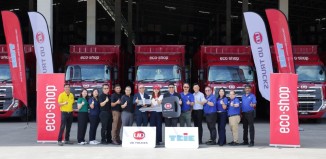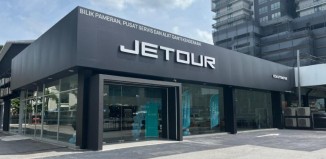Mitusbishi Triton 3.2
Is bigger better?
You bet it is. Your girlfriend is just being kind
The Triton 3.2 was not born under the best of moons, it was launched days after the Government announced that petrol and diesel retail price would jump by roughly 80 cents but there is no denying that the larger engine improved its appeal.
Now that fuel prices are on the way down again, there may be a case for the bigger engine but only time will tell whether customers are willing to fork out extra for the extra displacement in terms of price, road tax and fuel bill.
So what makes the 3.2 Triton different from the standard Triton?
Firstly, it looks different, there are nice shiny bling bits on the grille and all over the pick-up and this lifts the Triton from being just a stylish load carrier to being a genuinely flashy vehicle.
You may wonder how many buyers want their pick-up truck to sparkle and the answer is quite a few. Just look at Isuzu’s D-Max Hi-DEF.
The good thing about the Triton 3.2 is that Mitsubishi is starting with a handsome product and need to do very little to stay ahead of the field.
The chrome grille insert and redesigned front bumper do a good job to make the Triton look more masculine and sophisticated. Well, sophisticated in a utilitarian sort of a way.
Changes in the cabin include a nice stereo that plays all formats known to man and nice leather trimming on the steering wheel and gear lever, other than that, you get the on board computer that can tell you either direction of travel, fuel consumption data or just the time. You choose what information you want to know.
I have always liked the way the Triton’s cabin looks because it is curvy and looks a lot more friendly than the usual severe boxy design of other pick-up truck interior
Of course the Triton still wins hands down when it comes to cabin space, it is the limousine of pick-up trucks, really, it really is that much more spacious when compared to the other trucks.
Thanks to the larger, more relaxed engine, the high-quality stereo has enough silence and serenity to show off its capabilities and turn the cabin into a very decent place to be when stuck in a traffic jam or when you are on long drives.
But you have to keep in mind that this is still a pick-up and diesel engines do shake and rumble more than petrol units so do not expect it to be as quiet as a regular car, even if the 3.2-litre engien si one of the msot refined foudn in a vehicle that can easily becoem a commercial carrier.
The Triton’s driving environment is a good place to be in as the basic ergonomics is excellent. It is so easy to get comfortable in the Triton.
A pick-up truck, even one that comes from Mitsubishi is not designed to put smiles on the face of drivers who like to go on fast Sunday drives on twisty back roads but the Triton is surprisingly good company even on the day of rest.
In order to extract the most of the Triton’s handling, you have to select four-wheel high on the drive mode and let power flow to all tyres, thsi way the vehicle will be a more willing accomplice on Sunday drives.
With all four tyres tugging away, teh Triton will turn steadily and firmly into corners but as with all 4WD cars, the pick-up will understeer into corners. Be firm with the steering wheel and let the front wheel bite in a bit more than necessary to adjust teh etnry attitude of the Triton then just power out and let the engine power keep you out of trouble.
I almost always keep pick-up trucks in four-wheel high when driving in the rain and it makes a world of difference especially when there is standing water. All you get is a bit of steering tug before the vehicle continues on a straight line. Don’t get me wrong, the laws of physics still insists on aquaplaning but the all wheel drive increases directional stability.
Conclusion
The larger engine makes the Triton an even more comfortable pick-up truck, it spins more lazily and the lower engien speed adds to the calm of the cabin and this can be an important consideration for someone who treasures comfort. the extra torque would also be welcome if you are inclined to towing a trailer.
The RM94,000 price tag is RM7,000 higher than the 2.5 but I think it is worthwhile if youhave the extra cash.
Specifications
SPECIFICATIONS
Body type Double Cab
Drive system 4WD
Price class GLS
DIMENSIONS AND WEIGHT
Overall length (mm) 5,075
Overall width (mm) 1,800
Overall height (mm) 1,795
Wheelbase (mm) 3,000
Track (mm) Front: 1,505 Rear: 1,500
Bed interior length (mm) 1,325
Bed interior width (mm) 1,470
Bed interior height (mm) 405
Min. ground clearance (mm) 220
Cargo floor height (mm) 865
Curb weight (kg) 1,905
Gross vehicle weight (kg) 2,930
Seating capacity 5
PERFORMANCE
Max speed * (km/h) 172
Min. turning radius (m) 5.9
ENGINE
Code 4M41 D1-DC IT
Type DOHC 16-valve, in-line 4-cylinder diesel with turbo intercooler
Displacement (cc) 3,200
Bore & Stroke (mm) 98.5 x 105
Compression ratio 17.0
Max. output (ECC Net) – kW(PS) / rpm 118(160)/3,500
Max. torque (ECC Net) – N-m(kg-m) / rpm 343(35.0)/2,000
ELECTRICAL & FUEL SYSTEM
Fuel supply equipment Electrical fuel injection (Common rail)
Fuel tank capacity (litres) 75
DRIVE SYSTEM
Type Easy Select 4WD
TRANSMISSION
Type 4-speed automatic with high/low transfer
STEERING
Type Rack-and-pinion with power steering
SUSPENSION
Front Independent-wishbone, coil springs
Rear Rigid, elliptic leaf springs
BRAKE
Front 16″ Ventilated disc
Rear 11.6″ Leading & trailing drums
TIRES & WHEELS
Front and rear 265/70R16 112S
Wheels 16″x7JJ


























